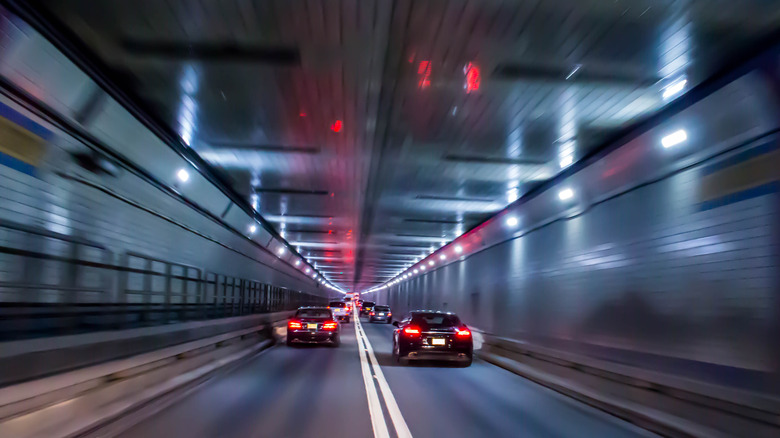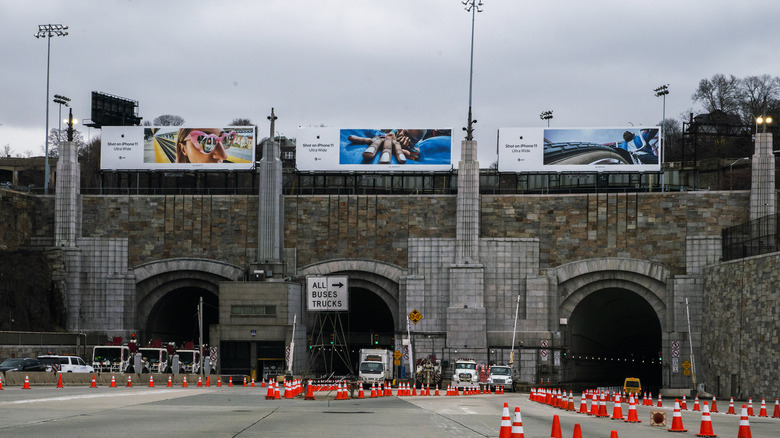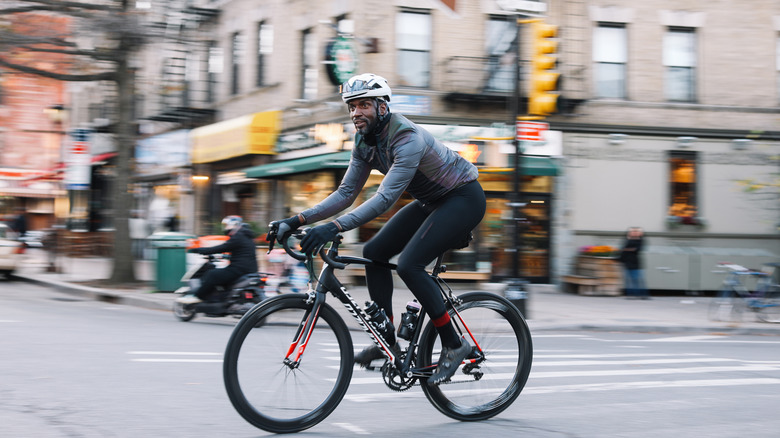The Most Congested Tunnel In The US Is Also One Of The Most Dangerous In The World
If you plan to visit New York's Lower or Midtown Manhattan from New Jersey, there's a good chance the Lincoln Tunnel will help you get there. The tunnel, which connects the two states through the Hudson River and ejects cars just blocks from the famous Times Square, is one of only a handful of ways to reach Manhattan by car.
Like most places in the Big Apple, the Lincoln Tunnel is often packed with people. According to 2015 data from the American Highway Users Alliance, the roadway is the eighth worst bottleneck in the U.S. and the most congested tunnel in the country. The report noted that the average queue to get through the tunnel is 2.6 miles long, and motorists sacrifice 3.4 million hours annually due to delays. As of 2022, the Port Authority of New York and New Jersey reported that nearly 20 million vehicles traveled eastbound using the tunnel annually, averaging nearly 54,000 vehicles per day (and remember, that's only one way).
Given how busy the Lincoln Tunnel can get, it's no surprise that traffic can be a real concern for travelers. But more importantly, drivers should be aware of the potential dangers of using the tunnel before cruising inside.
The Lincoln Tunnel might not be as safe as it seems
The Lincoln Tunnel has been deemed safe enough to use and is periodically closed for routine construction and repairs. Still, it's unclear how structurally sound the tunnel really is, and according to a report by News 12, inspection documents from 2020 contained redacted and blacked-out sections. "They've made the document completely ineffective and not capable of being understood," Walter Luers, an attorney and trustee of the New Jersey Foundation on Open Government, told the outlet.
One point included in the public report was the need for repairs at the south tunnel roadway, though in-depth information wasn't provided. Even without the full inspection review, issues with the Lincoln Tunnel are evident once accidents strike. For instance, the tunnel made headlines in 2020 when a water main break triggered a leak, which startled drivers stuck inside (a viral video posted to X, formerly known as Twitter, documented the nightmarish scene).
Car accidents in the Hudson River underpass can also be especially dangerous, given how many vehicles are stuck bumper-to-bumper at rush hour and other high-traffic times. In 2023, for example, a car caught fire while in the tunnel, trapping neighboring motorists in a cloud of smoke. Thankfully, no one was hurt, per CBS New York, but the incident served as a reminder of how dangerous the congested roadway can be.
The tunnel is also off-limits to pedestrians and cyclists
Even when cars are stuck in gridlock in the Lincoln Tunnel, the channel is too dangerous for pedestrians and cyclists hoping to slip through. Unlike the Brooklyn Bridge, a popular tourist attraction that has designated pathways for walking and cycling visitors, the Lincoln Tunnel bans access to anyone not using a motorized vehicle.
Avoiding the tunnel when walking or cycling around might seem easy enough, but for those unfamiliar with the area, entering is an easy mistake to make, especially when relying on routing apps. In 2017, CBS New York reported that numerous bike couriers had accidentally commuted through the Lincoln Tunnel after following GPS directions on their phones.
If you plan to travel between New Jersey and Manhattan without a car, consider taking a PATH train instead. The trains have multiple stops in New Jersey, including in cities such as Newark and Hoboken, and transport passengers to and from the World Trade Center or 33rd Street. If you prefer to walk or bike, head to the George Washington Bridge, which recently renovated its pedestrian and cyclist paths. Note, however, that the bridge is located far north of the Lincoln Tunnel, connecting New Jersey's Fort Lee and Upper Manhattan.


